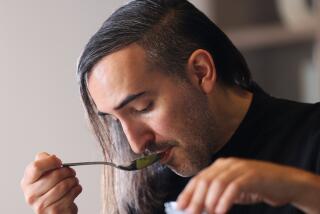Meet the Future Proprietor of Dino’s Bar & Grill
- Share via
Let me tell you about my dinner with Brandon.
Brandon Martinez, 14, has two earrings in his left ear, an ambition to restore a 1967 El Camino, and has snapped three skateboards doing airborne jumps. At school, he’s a so-so student, a ninth-grader who gets A’s in ROTC, hates English, thinks geometry is OK.
And, Brandon can cook like a demon.
He can whip up a dish of red snapper wrapped in Swiss chard, orange burgundy chicken, or penne with vodka cream sauce. He’s developed his own marinades and sauces. He’s baked cakes, pies, and tarts; on school nights he usually prepares dinner for his family, but not dessert, because he has homework.
Given the choice of attending his homecoming dance or a class on dough, Brandon learned to bake eggplant pizza, honey whole-wheat bread and the classic baguette. His hero? Emeril Lagasse, the chef who screams, “BAM!” to punctuate recipes on Food Network shows.
Brandon may be one of the few kids in America who hopes he gets a six-quart All Clad saute pan, a Wusthof knife set or an Emile Henry oval casserole for Christmas.
“Brandon is an accomplished cook,” said May Parich, instructor in a cooking course that Brandon takes at Pasadena’s HomeChef school, where I met him, the only youth in a class of 25.
How many kids are cooks? Experts say it’s an increasingly large number; they point to a proliferation of courses catering to youth, as well as the popularity of cooking shows on TV. Few, however, are serious enough to spend hours poring over recipes.
Many chefs start young. Wolfgang Puck, Ming Tsai, and Paul Prudhomme began cooking as boys. Pierre Franey’s family called him a gourmand when he was still a child. In Europe, apprentice chefs can begin at age 14--a practice prohibited in the U.S. With fine cuisine, as in music, child prodigies emerge.
“I call them the ‘Einsteins’ of our profession,” said Fritz Sonnenschmidt, who began cooking at age 10 and is now dean of the Culinary Institute of America in New York. “A young person has the ideas, concepts, and dreams, though maybe not the know-how, to make it work.”
Could Brandon be one of those Einsteins? I invited Brandon to prepare dinner for me and his family (groceries paid for by The Times). “Coooooool,” he said.
The Chef Wears Tennis Shoes
Brandon is a slender, poised 5 feet 8, who wears an oversized white T-shirt and his beige cargo pants slightly baggy, sagging onto his black Vans sneakers. His brown hair is short on the sides, while the top is long enough to slather with gel so it stands upright.
We met after school on a recent Monday. Brandon lives in a blue-collar Altadena neighborhood in a cramped, two-bedroom house with his mother, stepfather, 12-year-old sister, Brittany, and 6-year-old half-brother, J.T. The kitchen is so tiny that it’s impossible to open the refrigerator and stand at the stove. There is no dining room or dining room table; the family eats in the living room, on recliners around a 27-inch television.
Since Brandon began cooking in earnest 18 months ago, Gene Lewin, his stepfather, an unemployed electrician, has gained 15 pounds; his mother, Colleen, an electrical estimator apprentice, has gained 11. They’ve urged him to reduce his use of butter and cream. But to Brandon, a recipe is meant to be honored; improvisation is OK, but not butchering for calorie-cutting.
Brandon tackles recipes complicated enough to confound most adults. He has the patience to spend several hours creating a tart, making and rolling the dough, mixing a cream filling, carefully laying out raspberries and thin slices of kiwi, strawberries, pineapple, and oranges, and finally topping it with an apricot jelly glaze.
Friends have seen him ollie-pop his skateboard up in the air. They’ve played Rainbow Six and Elite Force with him on the computer. They know he rides 12 miles on his racing bike, going from his house to the Rose Bowl, where he does two laps.
But Brandon has never cooked for “the guys.” They tease him about spending time in the kitchen, saying it’s for girls or gays. Only Brandon’s girlfriend has tasted his cooking.
“I consider myself just like my friends; the only thing different is I cook,” Brandon says. “Sometimes I think of myself as a little cooler because I have, like, you know, the talent but I don’t rub it in their faces.”
My afternoon with Brandon began inauspiciously when he forgot his house keys, locked himself out, and discovered he left his shopping list inside. We drove to his cooking school for copies of recipes. Then to Bristol Farms, where he had never shopped.
At HomeChef, Brandon works as a preparation assistant, getting a 15% discount on the 12-week course called Essential Cooking. It means he gets up Saturdays at 7:30 a.m. It also means he had to give up playing soccer.
But it’s all part of a plan. After graduating from high school, he figures he’ll join the Army to pay for college: Cal Poly Pomona for restaurant courses, then a stint at the Culinary Institute of America.
Brandon envisions an international chain of his restaurants. He’ll call it Dino’s Bar & Grill, because he was nicknamed Brandino when he was little and crazy about dinosaurs. “I’ll change the menu every week--one week it’ll be classic American, the next, it’ll be Italian,” Brandon says, his brown eyes glowing.
If you ask Brandon why he takes such an interest in cooking, he shrugs. It’s fun. It’s easy. He likes to eat what he cooks. “It’s a walk in the park,” he says.
It was at his grandfather’s house where Brandon learned to tend the grill, getting his own set of tongs at age 5. His stepfather and father, Patrick Martinez, a truck driver, say cooking is Brandon’s way of expressing himself.
“He’s in his little world in cooking,” says his mother. “When there’s something on TV, then he’s a 14-year-old kid again.”
Putting the Menu Together
For my dinner, Brandon has decided to cook roast pork tenderloin with Madeira sauce, penne al forno, and lime saffron rice. Vegetables? Nah. Brandon makes a 14-year-old’s choice.
He had once cooked roast pork tenderloin but it turned out too dry. So he wanted to try again. He had never made Madeira sauce, or this particular pasta or rice.
At Bristol Farms, after selecting the meat, we cruised over to the vegetable aisle. Brandon insisted he needed a “leek carrot.” He pointed to his recipe, which was missing a comma between the two vegetables. We selected a leek and a carrot.
Saffron was next. Brandon wanted to be sure the saffron was threads, not powder. Lastly, cheese. “Grrrrrr--Grrrr-- I’m not good at pronouncing foreign stuff,” he said, thrusting the recipe toward me. We found the Gruyere.
We returned to his empty home by 3:30 p.m. The landlord’s son found a spare key and let us in. Unwashed bowls and silverware were piled on the brown tile counter in the kitchen. Brandon groaned.
The two things Brandon hates? Washing dishes and cutting onions. But he removed his Dr. Seuss watch and attacked the dishes, explaining it was a house rule that you can’t cook in a dirty kitchen.
When the kitchen was clean, a 2-foot-by-10-inch swath materialized on the cluttered counter. This was his preparation space.
Has he had any culinary disasters? “I don’t want to talk about it,” he rolled his eyes. Just the day before, he baked a chocolate cake and neglected to let the pan cool sufficiently, so it came out in chunks. Another time he constructed a platter of sushi and put it in the refrigerator--it toppled to the floor when the fridge was opened. Or there was the spinach rice, which he scorched the first time and then made too spinachy on a second try.
“I’m easily distracted when friends are here,” he explained.
Brandon showed me his two good knives, one a utility knife, the other an 8-inch chef knife. His mother and stepfather bought him a pricey nine-piece set of All Clad pots, a seven-quart French oven, a double boiler, a silicone cookie sheet and heat-resistant spatulas. It was a large expense for the family, so Brandon understood when his skateboard broke that it wouldn’t be immediately replaced. As it is, Colleen started working part time as a sales clerk evenings and weekends at HomeChef, which gives her a discount on purchases.
“It’s not keeping up with the Joneses, it’s keeping up with Brandon. Sometimes he’d start talking and I wouldn’t know what he was talking about--like creme fraiche,” said Colleen, referring to cultured cream. When Brandon began discussing “mise en place,” Colleen asked if that was something else she needed to buy, and he explained it was French for a concept of everything having its place.
“I used to keep him out of the kitchen when he was small because I didn’t want him to get hurt or get underfoot--well, now I’m the one who’s underfoot,” Colleen said.
Colleen figures Brandon is learning practical skills; she wishes she could do more for her son. “It’s not like he wants to be a potter and I’ll get stuck with a potter’s wheel in my garage,” she said. “It hurts me a lot that I can’t get him everything. He gets most of what he wants and everything he needs.”
On the afternoon I spent with Brandon, Colleen was at her job as an electrical estimator.
Brandon set about making the sauces for the penne al forno. “It’s basically an adult version of macaroni and cheese,” he explained, correctly predicting that his younger brother, J.T., would like it.
For this dish, Brandon first had to make a white sauce, then a cream sauce, and finally a cheese sauce. The pasta, after being cooked al dente, would be placed in a pan, topped with bread crumbs and baked. (He omitted the onion because he hates chopping onions, and he didn’t think J.T. would like the flavor.)
He effortlessly whisked together ingredients, careful not to let any skin form as the milk came to a boil. The white sauce contained no unseemly lumps. He was tired because he’d stayed up until midnight the night before watching the movie “The Shining” on TV. But he moved quickly through the kitchen, his hands darting from pot to pan.
For the Madeira sauce, it cannot be helped, Brandon must cut an onion. His eyes watered. The radio played and Brandon occasionally sang along.
We hit a basic question with the leek. “What part of this am I supposed to use?” he asked. “It’s my first leek experience.”
At 4:45, he discovered the leek was sticking to the pot. Unfazed, Brandon mixed the demi-glace. He was worried about the Madeira sauce. “I don’t think the vegetables were supposed to be this big,” he said, concerned that he should have chopped more finely.
As he juggled the two sauces, he launched into the lime saffron rice. At 5:06 p.m., an acrid smell filled the kitchen. “Oh gosh,” Brandon exclaimed, finding the wooden spoon handle, resting by a gas burner, had caught fire. Five minutes later, Brandon drained the pasta.
“C’mon, melt,” Brandon ordered the tablespoon of butter, sitting atop the penne. At 5:16 p.m., the rice was almost boiling. Usually Brandon takes a break from cooking at 5:00 to watch a TV cartoon called “Dragon Ball Z.” But on this day, everything needed tending. He dashed from the room, checked the TV, and returned announcing with relief, “It’s a rerun.” Then he squeezed lime juice into a measuring cup. Brandon was aiming for a 6:15 p.m. dinner.
With several swift strokes of the knife, he expertly trimmed fat from the meat. He sprinkled the tenderloin with sweet Hungarian paprika, freshly ground black pepper, and sea salt.
At 5:27, he slid the meat into the oven, leaving a pizza stone on the oven rack. He turned on a small fan and opened the windows. The pizza stone was smoking. Moments later, the smoke alarm shrieked.
Brandon’s sister, Brittany, charged into the kitchen as Brandon frantically waved a dish towel to silence the smoke detector. “It’s not always like this--just when he tries new stuff,” said Brittany, who’d arrived home shortly after we had.
Meanwhile, the Madeira sauce had begun to stick again. The smoke alarm rang for the third time. The penne had to come out of the oven. After the alarm went off a fifth time, he disconnected the battery, then poured the lime into the basmati rice. “Oh God, it’s a little too moist,” he fretted.
But Brandon faced a bigger problem. The recipe called for straining the Madeira sauce, which had formed a non-liquid glop in the pan. “I guess it’ll take a couple of more tries,” said Brandon, eyeing the mixture with disappointment.
After the rest of his family got home, Brittany padded into her room and flicked on a light, which tripped a circuit breaker. The kitchen went dark.
Brandon’s spirits were unquenchable. After light was restored, he turned to his mother: “I don’t like the Madeira sauce--the wine flavor is too strong.”
Colleen peered skeptically into the pan, suggesting that maybe he had reduced the sauce too much. Then she read over his recipe. “Brandon, did you use the four cups of brown stock?”
Brandon gulped. “Where did it say that?”
Colleen pointed to the recipe.
Brandon shrugged, “So I read it wrong.”
Colleen advised adding liquid and salvaging the sauce--a suggestion that Brandon rejected, deciding the sauce was doomed. She stepped in anyway.
(Madeira sauce is difficult and Brandon’s reaction was reasonable, said Sonnenschmidt of the Culinary Institute. “I would have done the same thing if I thought I couldn’t repair it. He has the drive to do something new--that makes a good chef.”)
Brandon sliced off a taste of the pork tenderloin. How was it? “Perfect,” he said triumphantly.
Indeed, the tenderloin was succulent and tender. The rice had a marvelous lime flavor. The redone Madeira sauce was tasty. The pasta was comforting, somewhat bland, perfect for J.T.
Brittany, who doesn’t like meat, would only try a teeny piece. J.T. spooned the lime saffron rice into his mouth and started to spit it out. Colleen ordered him to swallow.
Brandon had his own evaluation: Too much saffron. Next time, more sauce for the pasta. The meat? Pretty good. He won’t mention the Madeira sauce.
With this, Brandon turned up the muted volume and focused on the TV, where the New England Patriots battled the New York Jets.
I ate seconds.
(BEGIN TEXT OF INFOBOX / INFOGRAPHIC)
Top 10 Dinners
in U.S. in 1999
1. Pizza
2. Spaghetti
3. Soup
4. Baked chicken
5. Steak
6. Pork chops
7. Hamburger
8. Salad
9. Frozen entrees
10. Tacos and burritos
Source: NPD Group Inc., a market research firm based in Port Washington, N.Y.
More to Read
Eat your way across L.A.
Get our weekly Tasting Notes newsletter for reviews, news and more.
You may occasionally receive promotional content from the Los Angeles Times.










